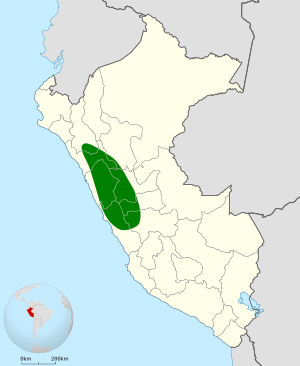Rufous-backed Inca finch facts for kids
Quick facts for kids Rufous-backed Inca finch |
|
|---|---|
| Conservation status | |
| Scientific classification | |
| Genus: |
Incaspiza
|
| Species: |
personata
|
 |
|
The rufous-backed Inca finch (Incaspiza personata) is a small bird that lives in Peru. It's known for the reddish-brown feathers on its back. This bird is a type of finch, and scientists usually place it in the family called Emberizidae (which includes buntings and sparrows). However, some experts think it might be more closely related to the Thraupidae family, which includes tanagers.
This special finch is endemic to Peru. This means it's found only in Peru and nowhere else in the world! Its natural home is in high-altitude areas, where it lives among shrubs and small trees.
Contents
About the Rufous-backed Inca Finch
The rufous-backed Inca finch is a unique bird because it only lives in a specific part of the world. It was first officially described by a scientist named Osbert Salvin in 1895. This bird is part of the Incaspiza genus, which is a group of finches named after the ancient Inca civilization of Peru.
Where It Lives
This finch prefers to live in places that are high up in the mountains. Its home is in the Andes Mountains of Peru. It likes areas with lots of shrubs, which are like small bushes. These places are often called "shrublands." The climate there can be subtropical or tropical, but because of the high altitude, it's not always hot.
What It Eats
Like many finches, the rufous-backed Inca finch likely eats seeds, insects, and other small plant parts. Birds often find their food by foraging on the ground or in the bushes where they live.
How It Looks
The most noticeable feature of this finch is its rufous, or reddish-brown, back. This color helps it blend in with its shrubland habitat. Finches are generally small birds, and their beaks are usually shaped for cracking open seeds.
Conservation Status
The rufous-backed Inca finch is currently listed as "Least Concern" by the International Union for Conservation of Nature (IUCN). This means that, for now, its population is stable, and it's not considered to be in danger of disappearing. However, it's always important to protect the natural homes of all animals, especially those that only live in one country.
See also
 In Spanish: Incaspiza dorsirrufo para niños
In Spanish: Incaspiza dorsirrufo para niños


